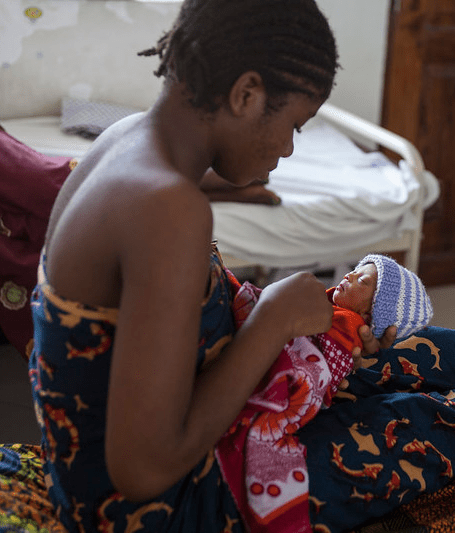Tanzania
Approximately 70,000 children are living with HIV in Tanzania; in 2024, there were an additional 5,100 new infections due to vertical transmission.
Background
Tanzania’s vertical transmission prevention (VTP) program, spearheaded by the Directorate of Reproductive, Maternal and Child Health, works closely with key stakeholders to ensure the implementation of interventions that focus on improving access to quality HIV, Hepatitis B, and Syphilis for pregnant and breastfeeding women (PBFW). Priority interventions include triple HIV/Syphilis/Hepatitis B testing, HIV retesting for PBFW, early infant diagnosis (EID), viral load monitoring, provision of ART to women living with HIV, prophylaxis to infants exposed to perinatal HIV, and tracking mother-infant pairs.
Progress toward elimination targets, 2024
| Elimination of vertical transmission | |
|---|---|
| Pregnant women who received ART for VTP (#) | 66,900 |
| Pregnant women needing ART for VTP (#) | 68,000 |
| Coverage of pregnant women who received ART for VTP (%) | 95 |
| Early infant diagnosis < 2 months of age (%) | 71 |
| New HIV infection among children (#) | 5,100 |
| New HIV infections averted due to VTP interventions | 18,000 |
| Final vertical transmission rate including during breastfeeding (%) | 7.6 |
| Number of HIV-exposed children who are uninfected | 910,000 |
| Source: UNAIDS country estimates, 2025 | |
HIVE Engagement
Tanzania joined the HIVE network in October 2024, after a sensitization meeting and baseline visit by the ICAP-HIVE team with the Ministry of Health, recipients of care, UN agencies, PEPFAR agencies, and other implementing partners. Since then, Tanzania has actively participated in the HIVE network activities, including piloting the HIV Vertical Transmission Elimination Capability Maturity Model (VTE CMM).
In December 2024, Tanzania conducted a baseline assessment of the country’s VTP program using the VTE CMM, which identified strengths in coordination, community engagement, training, procurement, ART coverage, service quality, and neonatal syphilis. The assessment also highlighted gaps in the following areas:
-
- VTP cascade in HIV testing policy
- PrEP
- differentiated ART
- Viral load monitoring
- Operational guidance
- Early infant diagnosis
- Neonatal hepatitis
The figure below shows the baseline national VTE assessment results, with dark green indicating where Tanzania is doing well.

Overview of Tanzania’s 2024 VTP self-assessment results
Service Disruptions and Landscaping Survey
The months following the issuance of a US government Executive Order EO in January 2025, which led to a pause in all USG-funded HIV treatment activities, critically affected Tanzania’s VTP program. Blood sample transportation was disrupted, affecting early infant diagnosis samples and viral load monitoring among other critical activities, leading to the pooling of samples and decreased sample collection in some regions. The suspension of data entry clerks affected routine data processes, including the entry of recipient of care information into the electronic database, compromising the quality of data and timely reporting. There was decreased onsite technical support by the PEPFAR implementing partners, which compromised the quality of services and data quality. Following the issuance of a waiver, VTP services in Tanzania have been resumed. In response to the effects HIV services faced as a result of the EO, Tanzania’s government has transitioned the sample logistic systems to the Tanzania Post Corporation with regional-level oversight. Additionally, the government increased the utilization of national monitoring and evaluation systems such as the DHIS2 and Unified Community System (UCS) to reduce dependence on donor-led data entry.
Alignment with the Global Alliance
Tanzania is one of 12 countries that joined the Global Alliance to End AIDS in Children by 2030. The country’s priority interventions aim to close the treatment gap for pregnant and breastfeeding women, promote early antenatal care booking and institutional delivery, roll out triple elimination of vertical transmission of HIV, syphilis, and Hepatitis B, and institute adolescent-friendly VTP services. The country has prioritized retesting services, the scale-up of PrEP, and the implementation of HIV self-testing for partners of PBFW, including adolescents, to improve the detection of new HIV infections and reduce vertical transmission.


